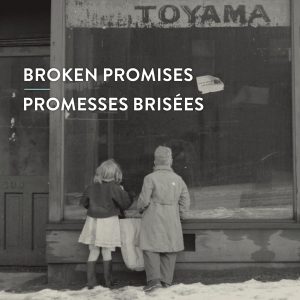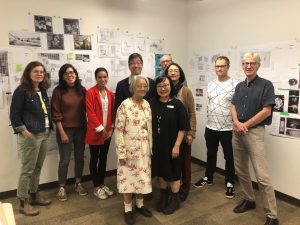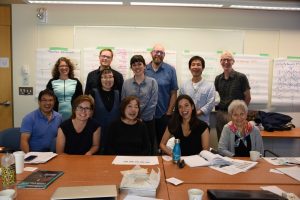Broken Promises Museum exhibit
Broken Promises the Landscapes of Injustice Museum Exhibit
Yasmin Amaratunga Railton, PhD
Jack Lindsay. City of Vancouver Archives, 1184-1537
The Broken Promises museum exhibit is the capstone output of the Landscapes of Injustice (LOI) project. Broken Promises opens to the public on 26 September 2020 at the Nikkei National Museum & Cultural Centre (Burnaby), before touring across Canada to the Japanese Canadian Cultural Centre (Toronto) and the Royal British Columbia Museum (Victoria). In this article, LOI Curatorial Postdoctoral Fellow Yasmin Amaratunga Railton, PhD shares her experience curating Broken Promises with Sherri Kajiwara (Nikkei National Museum) and Leah Best (Royal British Columbia Museum).
In many ways, museum curation can be thought of as a form of storytelling. Extending this metaphor, curators are not so much authors as translators of knowledge. The story of the dispossession of Japanese Canadians in the 1940s by the Canadian government is not a singular narrative. Research undertaken by the Landscapes of Injustice project illustrates how the violence of dispossession unfolded over years of bureaucratic work, and in the daily experiences of those being administered. It required the complicity of thousands. Losses of home and place were specific harms to which Japanese Canadians made complex and varied responses. These losses are still felt today.
In Broken Promises, we endeavoured to translate new research on this topic while remaining rooted in community knowledge networks. To effectively do this, we adopted what is known as participatory exhibit-making, an approach to curation that promotes consultation with experts and enables those with lived experiences to tell their stories. We conducted community consultation at every stage of exhibit development, often moving beyond consultation into the realm of collaboration. As this exhibit will be travelling across Canada, our goal was to ensure we convey the relevance of this story today within the context of Canadian history.
To tell the story of individual and collective experience of Japanese Canadians in Broken Promises, we highlighted seven narrators. These narrators emerged from a research process identifying individuals across a range of socio-economic backgrounds, vocations, and distinct experiences of loss. Our narrators are introduced in the first section of the exhibit. Their stories are knitted together through the historical chronology of internment and dispossession. Through the exhibit you learn about their rich and varied experiences in Canada before World War II, the administration of their lives during and after the war, and how legacies of dispossession continue to this day.
Intrinsic to good storytelling has always been the practice of good listening. Hours of discussion went into the selection of thousands of archival documents, photographs, letters, and oral histories to convey the experiences of Japanese Canadian families. I’ve been honoured to sit in the homes of our narrators and to listen to their stories. To understand the story of Masue Tagashira, research coordinator Kaitlin Findlay and I spent a day with three generations of the Tagashira family. Over tea and biscuits, Donald, Charles, and Emma Jinnouchi shared stories and dozens of family photo albums. Members of the Kagetsu family joined our curatorial workshops at the Nikkei National Museum as we developed exhibit content about their family. In Ottawa, Sachiko Okuda shared stories about her father, and her own experience joining the Redress campaign and leading the Ottawa Japanese Cultural Centre.
Landscapes of Injustice Museum Exhibit Cluster with members of the Kagetsu Family, 2019. Photo credit: Nikkei National Museum
To ensure the translation of research to visitors, we sought the advice of the Royal British Columbia Museum, the Nikkei National Museum, the Canadian War Museum, and the Canadian Museum of Immigration. We circulated draft text with the Landscapes of Injustice Community Council, as well as with historians, geographers, and legal scholars. Canadian primary and secondary teachers tested interactive elements for usability. We hosted public sessions at the Powell Street Festival and invited the public to give feedback on schematics and to respond to specific stories and images. I was particularly moved by Emma Nishimura’s artwork, which encapsulates so poignantly her family’s history and her response to learning about it. These artworks now form part of the Legacy section of the exhibit and you can hear Emma talk about her work in the oral history theatre.
Like any community consultation, ours had its limitations. We are sensitive to the fact that there is not always consensus within the broader Japanese Canadian community on subjects ranging from language and euphemisms to the ethics of making research findings public. To meet the challenges of telling this story, we adopted a number of tools to engage different voices. These included convening a research integration committee of academics and holding regular meetings with our Community Council, a committee comprised of Japanese Canadian advisors from across the country. I feel privileged to have worked with, learned from, and developed deep friendships with Mary Kitagawa and Vivian Wakabayashi Rygnestad in this process.
Landscapes of Injustice Museum Exhibit Cluster, 2018
Photo credit: Tosh Kitagawa
Storytelling also supports dialogue for social change. Having public consultations across British Columbia held an important educational function in communicating this history and promoting dialogue about racism. Further stories emerged from these discussions. In a community consultation session in the Gulf Islands, Rose Murakami, whose sister Mary is a narrator in our exhibit, shared with us the experience of finding her family’s belongings at yard sales for years after returning to Salt Spring Island after their forced uprooting.
As with all collaborative processes, participatory exhibit-making is an opportunity to acknowledge differing values and offers a safe space for discussion. This theme is expressed at the end of the exhibit itself in the form of a feedback feature. We invite you to reflect on this difficult history, and to join the conversation with researchers and the Japanese Canadian community. It is our hope that this exhibit will foster a personal connection to this history and will allow for the continuation of the story.
We are excited to welcome you to the exhibit launch at the Nikkei National Museum & Cultural Centre
Saturday, September 26, 2020
1:00-2:00 pm PDT/3:00-4:00 pm EDT
Live stream and virtual programming
For more information visit: https://centre.nikkeiplace.org/exhibits/broken-promises
Or contact Michael Abe at info@landscapesofinjustice.com
This project has been made possible in part by the Government of Canada.




